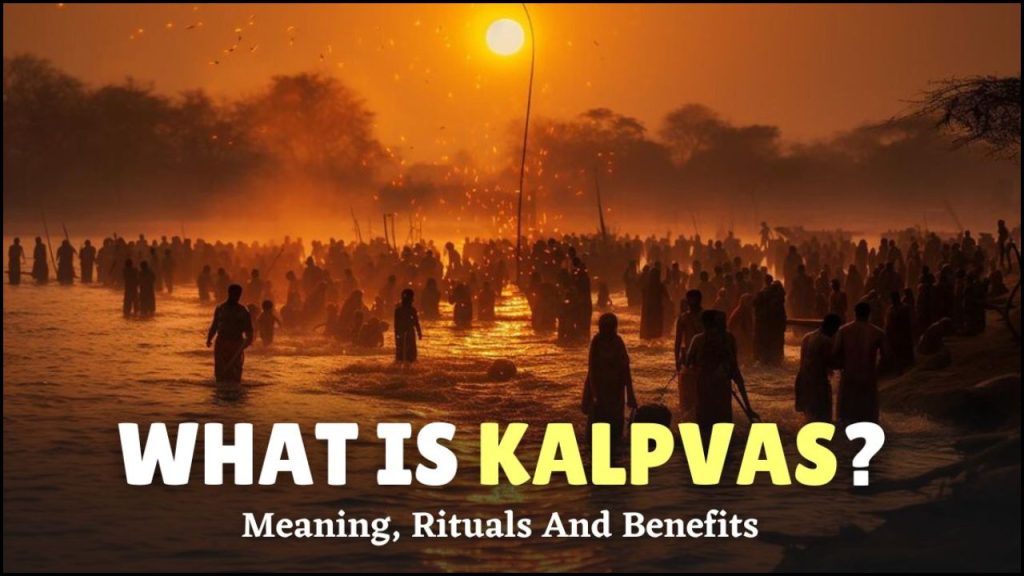
The journey to Kumbh Mela is a blend of spiritual surprise and soulful awakening. Rooted in ancient Hindu traditions, this sacred event brings thousands of devotees together at the holy banks of rivers. A calm morning at Triveni Sangam, surrounded by chanting and the scent of burning incense, sets the tone for an extraordinary inner journey. Among the many rituals of Kumbh, one powerful and ancient tradition is Kalpvas. This blog offers a deep understanding of Kalpvas, including its origin, purpose, benefits, and the spiritual rules followed during this intense period of devotion.
Table of Contents
Meaning of Kalpvas
- Term: Kalpvas is derived from two Sanskrit words – ‘Kalp’ meaning tree, and ‘Vas’ meaning reside.
- Interpretation: Kalpvas refers to residing under a tree or in nature, away from worldly comforts, particularly near sacred rivers.
- Location: At Kumbh Mela in Prayagraj, Kalpvas is observed at Triveni Sangam—the confluence of the Ganga, Yamuna, and Saraswati rivers.
- Objective: The practice is believed to purify the body and mind, bringing the soul closer to spiritual enlightenment.
Origin of Kalpvas
- Scriptural Reference: Kalpvas is mentioned in the Matsya Purana, one of the eighteen significant Hindu Puranas.
- Mythological Background: It is believed that Lord Ram and Lakshman once spent a month on the Ganga’s banks, practising self-discipline and devotion.
- Historical Value: Though mystical, this ancient practice has continued for centuries, symbolising self-restraint, austerity, and detachment from materialism.
Timing of Kalpvas
| Event | Details |
|---|---|
| Start Date | 11th day of Paush (Hindu calendar month) |
| End Date | 14th day of Magh |
| Alternate Start | From Makar Sankranti |
| Duration Options | 1 night, 3 nights, 3 months, 6 months, 6 years or ideally 12 years for complete transformation |
Why is Kalpvas Practised?
Pilgrims who practise Kalpvas do so for self-improvement and spiritual elevation. It is considered a transformative path that changes how a person sees life, society, and their inner self.
Benefits of Kalpvas
| Benefit | Explanation |
|---|---|
| Escape from materialism | Kalpvas helps remove attachment to wealth and possessions. |
| Simple lifestyle | Encourages a basic way of living, leading to inner peace and clarity. |
| Improved focus | Regular meditation boosts mental clarity and increases productivity. |
| Stress reduction | The serene environment and spiritual activities reduce stress and anxiety. |
| Soul cleansing | A dip in the Sangam is believed to wash away sins and negative energies. |
Practices and Rules of Kalpvas
The path of Kalpvas is not easy. It demands complete dedication and obedience to spiritual rules. These rules form the foundation of the Kalpvas lifestyle.
Essential Rules Followed During Kalpvas
| Rule | Description |
|---|---|
| Truthfulness | Always speak the truth, no matter the situation. |
| Non-violence (Ahimsa) | Avoid harming any living being physically or emotionally. |
| Compassion | Show kindness and empathy towards all creatures. |
| Wake before sunrise | Rise at Brahm Muhrat (approx. 1 hour 36 minutes before sunrise). |
| Brahmacharya | Practise celibacy and abstain from sexual activities. |
| Detachment from materialism | Refrain from indulging in worldly pleasures or luxuries. |
| Self-control | Master your senses and question desires with reasoning. |
| Three daily baths | Take ritualistic baths in the river morning, noon, and evening. |
| Trikal Sandhya | Chant the Gayatri Mantra three times daily—morning, noon, and evening. |
| Charity | Give donations and serve the needy selflessly. |
| Restricted movement | Do not leave the Kalpvas area during the entire period. |
| Service to saints | Serve saints and spiritual leaders with devotion. |
| One meal per day | Eat only once daily, usually before sunset. |
| Pind daan | Pay respect to ancestors through traditional rituals. |
| Sleeping on the ground | Practice celibacy and abstain from sexual activities. |
| Chanting loudly | Recite mantras aloud throughout the day. |
| Daily worship | Devote time daily to prayer and spiritual connection with God. |
| Agni seva | Sit by the holy fire and offer prayers. |
| Avoid criticism | Refrain from judging or criticising others. |
| Satsang participation | Join spiritual discourses and surround yourself with truth. |
| Inner transformation | Avoid beds or comfort, and sleep directly on the ground. |
| No anger or jealousy | Let go of negative emotions to achieve peace. |
These rules are not just guidelines but the pillars of Kalpvas, creating discipline, clarity, and compassion in life.
How to Practise Kalpvas?
- Clothing: Wear white, yellow, or orange clothes that symbolise purity and detachment.
- Living Setup: Stay in tents or temporary accommodations near the river banks.
- Daily Routine:
- Wake up before sunrise.
- Bathe in the river three times daily.
- Participate in rituals, bhajans, and discourses.
- Follow silence or minimal speech for inner focus.
- Join community kitchens and serve others selflessly.
Facilities at Kalpvas by Era Camps
| Service | Details |
|---|---|
| Scenic Accommodation | Stay near Triveni Sangam with river views and peaceful surroundings. |
| Engagement Activities | Daily meditation, bhajan sessions, and yoga programmes. |
| Basic Needs | Staff and volunteersare available to assist pilgrims at all times. |
| Security and Guidance | Staff and volunteers are available to assist pilgrims at all times. |
| Early Bird Offers | Special discounts for early bookings. |
In Summary
Kalpvas is a divine journey of self-discipline and inner transformation. Despite cold weather and physical discomfort, thousands participate every year, drawn by the promise of peace and spiritual cleansing. The strength of Kalpvas lies in simplicity and surrender. With the sacred waters of Triveni Sangam, the air of devotion, and the chants of mantras, Kalpvas offers the perfect route to rediscover one’s soul.





